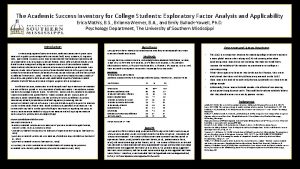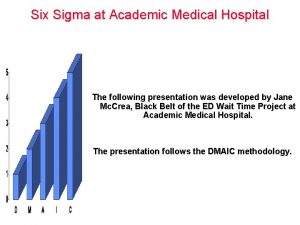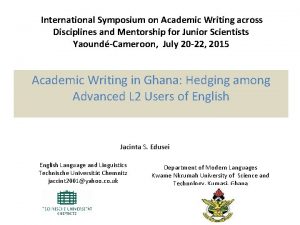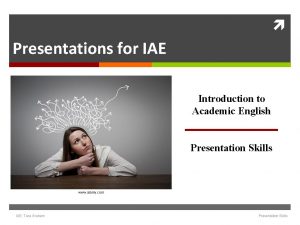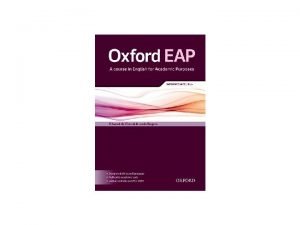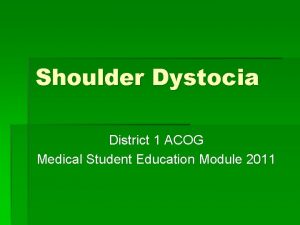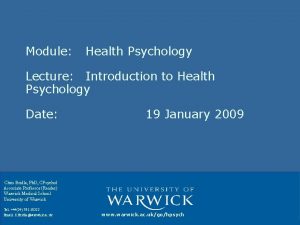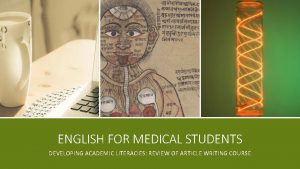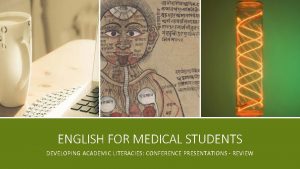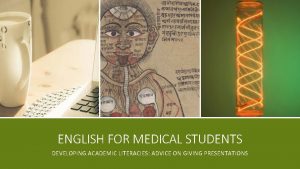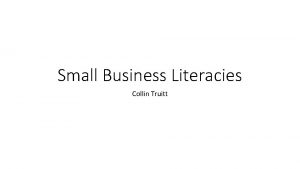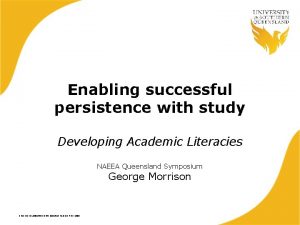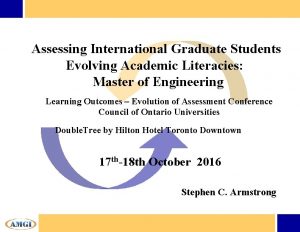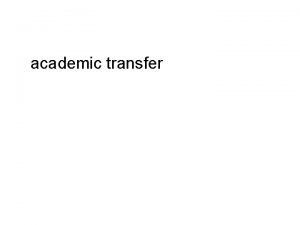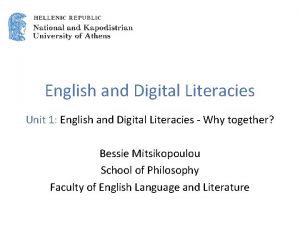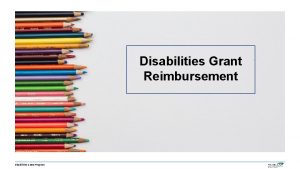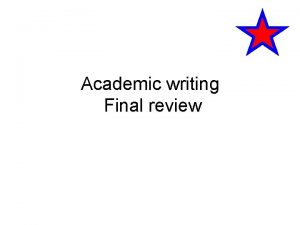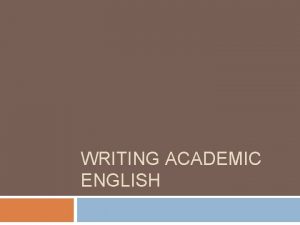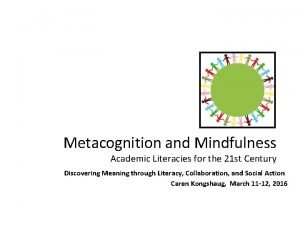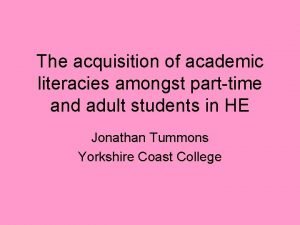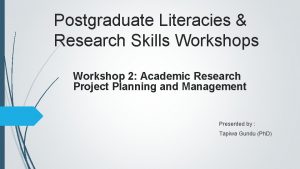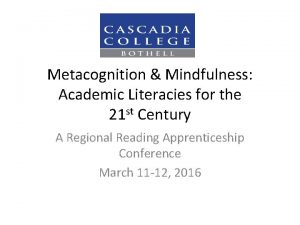ENGLISH FOR MEDICAL STUDENTS DEVELOPING ACADEMIC LITERACIES GRANT






















- Slides: 22

ENGLISH FOR MEDICAL STUDENTS DEVELOPING ACADEMIC LITERACIES: GRANT APPLICATIONS: PERSONAL STATEMENTS

TODAY’S SESSION ▪ General feedback & outstanding issues ▪ Focus on personal statements (grants & others) ▪ Final thoughts – where do we go next?

GENERAL FEEDBACK ▪ The virtue of redrafting ▪ Themes & variations ▪ Research articles versus grant applications ▪ Purpose & audience ▪ Outstanding issues ▪ Language accuracy & possible ways of addressing this? ▪ Other situations?

ASPECTS OF THE GRANT PROPOSAL ▪ Project narrative: ‘real-world need’ for the project ▪ Equipment and resources available ▪ Personal statement/biosketches/personnel justification ▪ Budget ▪ Full research plan ▪ References ▪ Letters of support

NIH PERSONAL STATEMENTS A. Personal statement B. Position and honors C. Contribution to science D. Research support

A. PERSONAL STATEMENT ▪ Claiming expertise ▪ I am an expert in both pediatric and adult inflammatory bowel disease with a laboratory-based research program on the mucosal immunology of chronic intestinal inflammation. ▪ I have been working in the field of innate immunity and innate control of adaptive immunity for about 14 years. In addition to a Ph. D. in Immunology, I have had postdoctoral training at Yale University, where I worked on understanding the importance of the TLR signaling pathway in activation of adaptive immune responses. ▪ My background in molecular genetics and genomics started with undergraduate research with a project to restriction map the genome of the Archaebacterium Sulfolobus solfataricus.

A. PERSONAL STATEMENT ▪ Claiming expertise ▪ I am an expert in both pediatric and adult inflammatory bowel disease with a laboratorybased research program on the mucosal immunology of chronic intestinal inflammation. ▪ I have been working in the field of innate immunity and innate control of adaptive immunity for about 14 years. In addition to a Ph. D. in Immunology, I have had post-doctoral training at Yale University, where I worked on understanding the importance of the TLR signaling pathway in activation of adaptive immune responses. ▪ My background in molecular genetics and genomics started with undergraduate research with a project to restriction map the genome of the Archaebacterium Sulfolobus solfataricus. State field of expertise: ▪ I am an expert in. . . I have expertise in… Length of time in the field: ▪ I have been working in the field for about… My background in X started with undergraduate research… Where was expertise gained? ▪ a laboratory-based research program…Postdoctoral training… Undergraduate research project…

A. PERSONAL STATEMENT CONTINUED ▪ The work of the laboratory/team/group ▪ My current NIH funding supports research relevant to the developmental pathways towards T-regulatory cell development. Specifically, we study coupling of KLF family transcription factor binding to chromatin modifying complexes leading to epigenetic change in gene networks regulating T cell phenotypes. We have published key epigenetic mechanisms regulating stability of FOXP 3 gene transduction and T regulatory cell development. ▪ My laboratory continues to work in the area of innate control of adaptive immunity and our more recent work has also focused on understanding molecular details of TLR signaling and molecular mechanisms by which the innate immune system regulates the adaptive immune responses. My lab has extensive experience in studying TLR mediated activation of adaptive immunity and our recent work has led to new understanding of regulation of immune responses in the gut (ref # 2 a), discovery of a new TLR signaling adapter that links TLRs to PI 3 K activation (ref # 3 a) and discovery of a rapid NLRP 3 inflammasome activation pathway controlled by IRAK-1 (ref # 4 a).

A. PERSONAL STATEMENT CONTINUED ▪ The work of the laboratory/team/group ▪ The major focus of my laboratory is on understanding our genome, using the zebrafish as a rapid molecular test system. We established the rapid use of morpholino sequence-specific knockdown technology for vertebrate functional genomics applications using the zebrafish as the pioneering model system fifteen years ago. In parallel, we developed vertebrate transposon tools including our protein trap gene-breaking vectors to generate a 700+ line collection of molecularly characterized and revertible mutant zebrafish lines, the first engineered conditional alleles in any organism outside the mouse. We have deployed transposons in diverse application areas including human T cells, zebrafish, and mice. Custom restriction endonucleases offer a third leg, targeted modification using genome editing tools. We continue to develop science behind these new engineering toolkits, working with an array of laboratories as diverse as rat, pig, mouse, nematode, and fly biologists in addition to regular colleagues that work in human cells and zebrafish.

A. PERSONAL STATEMENT CONTINUED ▪ The work of the laboratory/team/group ▪ What is the research focus of the lab? ▪ What are its achievements/publications? ▪ What is its recent work? ▪ How does it collaborate with others? ▪ If your work is not lab-based, then how does it relate to the work of others in the field? Do you collaborate/network?

A. PERSONAL STATEMENT CONTINUED ▪ State current position (if applicable) ▪ I am the director of the Pediatric Inflammatory Bowel Disease Clinic and coinvestigator in the adult IBD Clinic, where we collectively see over 4000 patients per year. ▪ As Director of the Genetics and Model Systems Core for the Center for Cell Signaling in Gastroenterology, I am delighted to support your project.

B: POSITION AND HONORS Positions and Employment ▪ 2000 -2005 Post-doctoral Associate, Howard Hughes Medical Institute, Yale University School of Medicine, New Haven, CT ▪ 2005 -2006 Associate Research Scientist, Section of Immunobiology, Yale University School of Medicine, New Haven, CT Professional Memberships ▪ 1999 Life member, Indian Immunology Society ▪ 2010 - Member, American Association of Immunologists Honors/Awards ▪ 1992 -1994 Indian Council of Agricultural Research’s Junior Research Fellowship ▪ 1994 -1999 Senior Research Fellowship from Department of Biotechnology, India ▪ 2013 AAI early career faculty travel award

C: CONTRIBUTION TO SCIENCE: FOCUS ON PUBLICATIONS ▪ The SLAM family regulates colitis through both adaptive and innate immune mechanisms. Upon joining the Terhorst laboratory in 2001, the SLAM family of immune receptors was known to be relevant to lymphoproliferative syndromes however precise mechanisms of immunoregulation were unknown. As part of this collaborative team, we defined the role for SLAM, CD 48, and Ly 108 in T cell and innate immune cellular function in colitis. As SLAM is a measles virus receptor, the major impact of our work on SLAM as a regulator of phagosome function is on the field of virology and retargeting of measles virus. ▪ a. Wang, N. Satoskar, A. , Faubion, W. A. , Howie, D. , Okamoto, S. , Feske, S. , Gullo, C. , Clark, K. , Sosa, M. R. , Sharpe, A. H. , Terhorst, C. (2004). The cell surface receptor SLAM controls T cell and macrophage functions. The Journal of Experimental Medicine, 199(9): 1255 -64. PMCID: 2211908. ▪ b. Howie, D. , Laroux, F. S. , Morra, M. , Satoskar, A. R. , Rosas, L. E. , Faubion, W. A. , Julien, A. , Rietdijk, S. , Coyle, A. J. , Fraser, C. , Terhorst, C. (2005). Cutting edge: the SLAM family receptor Ly 108 controls T cell and neutrophil functions. Journal of Immunology, 174(10): 5931 -5. PMID: 15879084

C: CONTRIBUTION TO SCIENCE: FOCUS ON PUBLICATIONS C. Contributions to Science [125 publications; google h index 48] ▪ 1) Biochemical and biological activities of hedgehog signaling in Drosophila and vertebrates. During my post-doctoral training, I contributed to uncovering mechanistic understanding how this key pathway works in a variety of critical processes and in the cloning of vertebrate family members including the first work using zebrafish implicating shh signaling as defective in holoprosencephaly. ▪ a) Lee, J. J. , Ekker, S. C. , von Kessler, D. P. , Porter, J. A. , Sun, B. I. and Beachy, P. A. (1994). Autoproteolysis in hedgehog protein biogenesis. Science 266, 1528 -1537. ▪ b) Ekker, S. C. , Ungar, A. , Greenstein, P. , von Kessler, D. P. , Porter, J. A. , Moon, R. T. , and Beachy, P. A. (1995). Patterning Activities of Vertebrate hedgehog Proteins in the Developing Eye and Brain. Current Biology, 5: 944 -955. c

C: CONTRIBUTION TO SCIENCE: A RESEARCH NARRATIVE ▪ When I started my post-doctoral work in the laboratory of Ruslan Medzhitov about 14 years ago, TLRs were only just discovered and not much was known about the various mechanisms by which TLRs influence adaptive immunity. In addition there was renewed interest in a population of cells called regulatory T cells or suppressor T cells. These cells, characterized by surface expression of CD 4 and CD 25 markers, were shown to be potent suppressors of naïve T cell activation. The general consensus was that these cells block activation of auto-reactive cells. A key question for us was: How do pathogen specific T cells over come the block induced by regulatory T cells to mount protective immune responses? We hypothesized that, since TLRs are major sensors of infections, TLR activation on DCs should be able to overcome suppression mediated by regulatory T cells (Treg cells). I used TLR-deficient and TLRsufficient dendritic cells for in vitro suppression assays to show that TLR activation on DCs overcomes the block induced by regulatory T cells. In addition I showed that surface maturation of DCs is not sufficient to overcome Treg cell mediated suppression. Finally I demonstrated that the cytokine IL -6 secreted by DCs in response to TLR ligands is responsible for providing critical signals necessary for naïve T cells to overcome Treg cell mediates suppression. In summary, I discovered that the Toll-pathway of DC activation controls adaptive immune responses by at least two major mechanisms; 1. By induction of surface maturation of DCs and 2: By inducing secretion of IL-6, which overcomes Treg cell mediated suppression. This study was described as ground breaking in a commentary that accompanied the published article in the journal “Science”.

D: RESEARCH SUPPORT ▪ Ongoing grants awarded ▪ Completed grants ▪ Reference number, PI, Date of award, Title of project, Role of applicant, Outcome(s). Ongoing Research Support 2 UL 1 TR 000135 -9 (PI: Khosla, S) 07/01/11 – 06/30/16 “Mayo Clinic Center for Translational Science Activities” Dr. Ekker is Associate Director for the Predoctoral training program in translational sciences, including the K-8 In. Sci. Ed Out science education reform initiative for the healthy community program. Completed Research Support 5 R 01 DA 14546 -10 (Ekker, PI) 05/01/01 – 06/30/14 “Intron-based Mutagenic Transposons for Zebrafish” The grant funded the development of the gene-break transposon technology for zebrafish functional genomics including the use of GBTs for behavioral genetics of the nicotine response.

ADAPTING FOR YOUR OWN PURPOSES ▪ What do you have expertise in? ▪ How long have you been working in the field? ▪ Are you an independent investigator or part of a lab/group? ▪ ▪ What is your/the lab’s research focus? What are your/its main achievements? What is your/its most recent work? How do you/does it collaborate with others? ▪ What are your publications? (Or what is your research narrative)? ▪ What other grants do you have/have you had?

ANOTHER TYPE OF PERSONAL STATEMENT Applying for a scholarship/exchange Move 1: Explain your reason for pursuing study in this field ▪ Explain your interest in the field. ▪ State your understanding of the field. ▪ Describe your motivation to study this area (personal background) Move 2: Establishing credentials ▪ List your academic achievements ▪ Describe your research experiences in the field to date ▪ Describe your professional experience in the field (internships, volunteering, etc)

ANOTHER TYPE OF PERSONAL STATEMENT Applying for a scholarship/exchange Move 3: Discussing relevant life experience ▪ Explain your extracurricular activities that show interest in helping others, taking responsibility, etc Move 4: State future career goals Move 5: Describe your personality: give examples of your personal development (eg confidence, teamwork)

FINAL THOUGHTS Where do we go from here?

AND… Have a good Christmas (and New Year, when it comes)!

ACKNOWLEDGMENTS ▪ Picture credits: ▪ Laboratório de Letramento Acadêmico, USP ▪ The Ayurvedic Man. A figure showing Ayurvedic understanding of human anatomy (detail), Pen and watercolour, Probably 18 th Century CE, probably of Nepalese origin, © Wellcome Library, London ▪ Barber DNA, by Robin Blackledge, © ©Robin Blackledge/Wellcome Images Sources of advice: https: //www. niaid. nih. gov/grants-contracts/write-research-plan
 Pretest: developing an academic and career plan
Pretest: developing an academic and career plan Academic success inventory for college students
Academic success inventory for college students Rizal champion of filipino students
Rizal champion of filipino students Six sigma at academic medical hospital case analysis
Six sigma at academic medical hospital case analysis Academic english reading and writing across the disciplines
Academic english reading and writing across the disciplines Academic english presentation
Academic english presentation Oxford eap a course in english for academic purposes
Oxford eap a course in english for academic purposes Helper in shoulder dystocia
Helper in shoulder dystocia Aim of health psychology
Aim of health psychology Pathology lectures for medical students
Pathology lectures for medical students Kontinuitetshantering i praktiken
Kontinuitetshantering i praktiken Typiska drag för en novell
Typiska drag för en novell Nationell inriktning för artificiell intelligens
Nationell inriktning för artificiell intelligens Returpilarna
Returpilarna Shingelfrisyren
Shingelfrisyren En lathund för arbete med kontinuitetshantering
En lathund för arbete med kontinuitetshantering Kassaregister ideell förening
Kassaregister ideell förening Personlig tidbok
Personlig tidbok Sura för anatom
Sura för anatom Förklara densitet för barn
Förklara densitet för barn Datorkunskap för nybörjare
Datorkunskap för nybörjare Boverket ka
Boverket ka Att skriva debattartikel
Att skriva debattartikel

